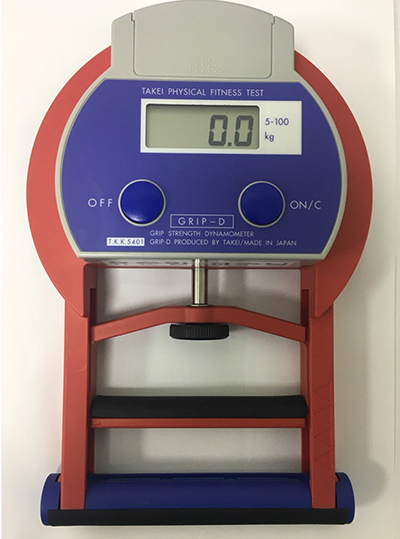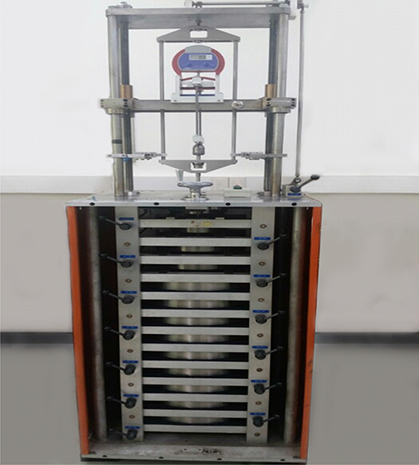J Bone Metab.
2018 Nov;25(4):243-249. 10.11005/jbm.2018.25.4.243.
Measurement of Uncertainty Using Standardized Protocol of Hand Grip Strength Measurement in Patients with Sarcopenia
- Affiliations
-
- 1Department of Orthopaedic Surgery, Chung-Ang University College of Medicine, Seoul, Korea.
- 2Department of Orthopaedic Surgery, Gyeongsang National University Hospital, Jinju, Korea. furim@daum.net
- 3Department of Rehabilitation Medicine, Gyeongsang National University Hospital, Jinju, Korea.
- 4Department of Preventive Medicine, Gyeongsang National University Hospital, Jinju, Korea.
- KMID: 2427990
- DOI: http://doi.org/10.11005/jbm.2018.25.4.243
Abstract
- BACKGROUND
The aim of this study was to determine the accuracy and error range of hand grip strength measurement using various methods.
METHODS
Methods used for measurement of hand grip strength in 34 epidemiologic studies on sarcopenia were analyzed. Maximum grip strength was measured in a sitting position with the elbow flexed at 90 degrees, the shoulder in 0 degrees flexion, and the wrist in neutral position (0 degrees). Maximum grip strength in standing position was measured with the shoulder in 180 degrees flexion, the elbow fully extended, and the wrist in neutral position (0 degrees). Three measurements were taken on each side at 30 sec intervals. The uncertainty of measurement was calculated.
RESULTS
The combined uncertainty in sitting position on the right and left sides was 1.14% and 0.38%, respectively, and the combined uncertainty in standing position on the right and left sides was 0.35 and 1.20, respectively. The expanded uncertainty in sitting position on the right and left sides was 2.28 and 0.79, respectively, and the expanded uncertainty in standing position on the right and left sides was 0.71 and 2.41, respectively (k=2).
CONCLUSIONS
Uncertainty of hand grip strength measurement was identified in this study, and a significant difference was observed between measurement. For more precise diagnosis of sarcopenia, dynamometers need to be corrected to overcome uncertainty.
Keyword
MeSH Terms
Figure
Cited by 1 articles
-
Association between Colorectal Adenoma and Hand Grip Strength in the Elderly
Ji Hyun Moon, Ye Ji Kim, Yun Hwan Oh, Mi Hee Kong, Hyeon Ju Kim
J Bone Metab. 2019;26(3):161-167. doi: 10.11005/jbm.2019.26.3.161.
Reference
-
1. Lin DC, Chang JH, Shieh SJ, et al. Prediction of hand strength by hand injury severity scoring system in hand injured patients. Disabil Rehabil. 2012; 34:423–428.
Article2. Eriksen CS, Garde E, Reislev NL, et al. Physical activity as intervention for age-related loss of muscle mass and function: protocol for a randomised controlled trial (the LISA study). BMJ Open. 2016; 6:e012951.
Article3. Beseler MR, Rubio C, Duarte E, et al. Clinical effectiveness of grip strength in predicting ambulation of elderly inpatients. Clin Interv Aging. 2014; 9:1873–1877.4. Roberts HC, Denison HJ, Martin HJ, et al. A review of the measurement of grip strength in clinical and epidemiological studies: towards a standardised approach. Age Ageing. 2011; 40:423–429.
Article5. Petersen P, Petrick M, Connor H, et al. Grip strength and hand dominance: challenging the 10% rule. Am J Occup Ther. 1989; 43:444–447.
Article6. Ha YC, Hwang SC, Song SY, et al. Hand grip strength measurement in different epidemiologic studies using various methods for diagnosis of sarcopenia: a systematic review. Eur Geriatr Med. 2018; 9:277–288.
Article7. Hamilton A, Balnave R, Adams R. Grip strength testing reliability. J Hand Ther. 1994; 7:163–170.
Article8. Dodds RM, Syddall HE, Cooper R, et al. Global variation in grip strength: a systematic review and meta-analysis of normative data. Age Ageing. 2016; 45:209–216.
Article9. Beaton DE, O'Driscoll SW, Richards RR. Grip strength testing using the BTE work simulator and the Jamar dynamometer: a comparative study. Baltimore Therapeutic Equipment. J Hand Surg Am. 1995; 20:293–298.
Article10. Lequin RM. Guide to the expression of uncertainty of measurement: point/counterpoint. Clin Chem. 2004; 50:977–978.
Article11. Fess EE. A method for checking Jamar dynamometer calibration. J Hand Ther. 1987; 1:28–32.
Article12. Amaral JF, Mancini M, Novo JM Júnior. Comparison of three hand dynamometers in relation to the accuracy and precision of the measurements. Rev Bras Fisioter. 2012; 16:216–224.
Article13. Chen LK, Lee WJ, Peng LN, et al. Recent advances in sarcopenia research in Asia: 2016 update from the Asian working group for sarcopenia. J Am Med Dir Assoc. 2016; 17:767.e1–767.e7.
Article
- Full Text Links
- Actions
-
Cited
- CITED
-
- Close
- Share
- Similar articles
-
- The Effect of Horticultural Program on Cognitive Function, Activities of Daily Living(ADL) and Hand Grip Strength of Institutionalized Dementia Patients
- Comparison of lower leg muscle strength and grip strength for diagnosing slower gait speed in the elderly
- Reliability and Validity of the Martin Vigorimeter for Grip Strength Measurement in Korean Adults
- Association between Grip Strength as Diagnostic Criteria of Sarcopenia and Health-Related Quality of Life in Korean Elderly
- Inverse correlation of serum uric acid and relative hand grip strength in Korean adult women





